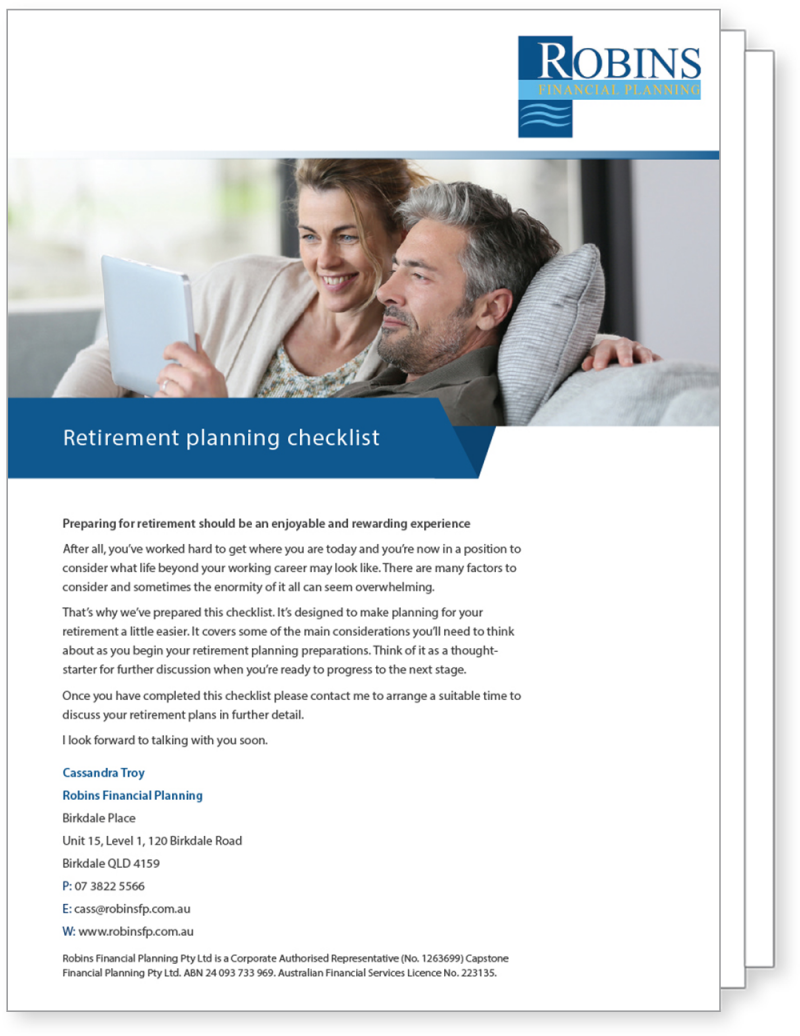Resources
-
Array
(
[0] => WP_Post Object
(
[ID] => 1576
[post_author] => 1
[post_date] => 2019-09-23 03:01:30
[post_date_gmt] => 2019-09-23 03:01:30
[post_content] => [vc_row][vc_column][/vc_column][/vc_row]
[post_title] => Introduction to Investing eBook
[post_excerpt] =>
[post_status] => publish
[comment_status] => open
[ping_status] => open
[post_password] =>
[post_name] => introduction-to-investing-ebook
[to_ping] =>
[pinged] =>
[post_modified] => 2019-10-15 06:52:00
[post_modified_gmt] => 2019-10-15 06:52:00
[post_content_filtered] =>
[post_parent] => 0
[guid] => https://robinsfp.com.au/?p=1576
[menu_order] => 0
[post_type] => post
[post_mime_type] =>
[comment_count] => 0
[filter] => raw
)
[1] => WP_Post Object
(
[ID] => 1578
[post_author] => 1
[post_date] => 2019-09-23 03:08:46
[post_date_gmt] => 2019-09-23 03:08:46
[post_content] => [vc_row][vc_column][/vc_column][/vc_row]
[post_title] => Estate planning guide
[post_excerpt] =>
[post_status] => publish
[comment_status] => open
[ping_status] => open
[post_password] =>
[post_name] => estate-planning-guide
[to_ping] =>
[pinged] =>
[post_modified] => 2019-10-15 06:51:37
[post_modified_gmt] => 2019-10-15 06:51:37
[post_content_filtered] =>
[post_parent] => 0
[guid] => https://robinsfp.com.au/?p=1578
[menu_order] => 0
[post_type] => post
[post_mime_type] =>
[comment_count] => 0
[filter] => raw
)
[2] => WP_Post Object
(
[ID] => 1605
[post_author] => 1
[post_date] => 2019-09-23 05:43:00
[post_date_gmt] => 2019-09-23 05:43:00
[post_content] => [vc_row][vc_column][/vc_column][/vc_row]
[post_title] => Is an SMSF right for you?
[post_excerpt] =>
[post_status] => publish
[comment_status] => open
[ping_status] => open
[post_password] =>
[post_name] => is-an-smsf-right-for-you
[to_ping] =>
[pinged] =>
[post_modified] => 2019-10-15 06:51:11
[post_modified_gmt] => 2019-10-15 06:51:11
[post_content_filtered] =>
[post_parent] => 0
[guid] => https://robinsfp.com.au/?p=1605
[menu_order] => 0
[post_type] => post
[post_mime_type] =>
[comment_count] => 0
[filter] => raw
)
[3] => WP_Post Object
(
[ID] => 1608
[post_author] => 1
[post_date] => 2019-09-23 05:56:30
[post_date_gmt] => 2019-09-23 05:56:30
[post_content] => [vc_row][vc_column][/vc_column][/vc_row]
[post_title] => Key financial considerations for small business owners
[post_excerpt] =>
[post_status] => publish
[comment_status] => open
[ping_status] => open
[post_password] =>
[post_name] => key-financial-considerations-for-small-business-owners
[to_ping] =>
[pinged] =>
[post_modified] => 2019-10-15 06:50:39
[post_modified_gmt] => 2019-10-15 06:50:39
[post_content_filtered] =>
[post_parent] => 0
[guid] => https://robinsfp.com.au/?p=1608
[menu_order] => 0
[post_type] => post
[post_mime_type] =>
[comment_count] => 0
[filter] => raw
)
[4] => WP_Post Object
(
[ID] => 1613
[post_author] => 1
[post_date] => 2019-09-23 06:00:03
[post_date_gmt] => 2019-09-23 06:00:03
[post_content] => [vc_row][vc_column][/vc_column][/vc_row]
[post_title] => Retirement Planning Checklist
[post_excerpt] =>
[post_status] => publish
[comment_status] => open
[ping_status] => open
[post_password] =>
[post_name] => retirement-planning-checklist
[to_ping] =>
[pinged] =>
[post_modified] => 2019-10-15 06:50:13
[post_modified_gmt] => 2019-10-15 06:50:13
[post_content_filtered] =>
[post_parent] => 0
[guid] => https://robinsfp.com.au/?p=1613
[menu_order] => 0
[post_type] => post
[post_mime_type] =>
[comment_count] => 0
[filter] => raw
)
[5] => WP_Post Object
(
[ID] => 1619
[post_author] => 1
[post_date] => 2019-09-23 06:09:03
[post_date_gmt] => 2019-09-23 06:09:03
[post_content] => [vc_row][vc_column][/vc_column][/vc_row]
[post_title] => Retirement Planning ebook
[post_excerpt] =>
[post_status] => publish
[comment_status] => open
[ping_status] => open
[post_password] =>
[post_name] => retirement-planning-ebook
[to_ping] =>
[pinged] =>
[post_modified] => 2019-10-15 06:49:48
[post_modified_gmt] => 2019-10-15 06:49:48
[post_content_filtered] =>
[post_parent] => 0
[guid] => https://robinsfp.com.au/?p=1619
[menu_order] => 0
[post_type] => post
[post_mime_type] =>
[comment_count] => 0
[filter] => raw
)
[6] => WP_Post Object
(
[ID] => 1916
[post_author] => 1
[post_date] => 2019-11-19 23:52:22
[post_date_gmt] => 2019-11-19 23:52:22
[post_content] =>
- Australian interest rates were lowered by 0.25% to 0.75% in October but left unchanged in November. Most observers expect borrowing costs to be lowered further in the next few months.
- The latest reading of Australian consumer confidence fell unexpectedly sharply. This was a little surprising given generally buoyant labour market conditions and declining mortgage costs.
- There has also been further evidence of an improvement in the Australian housing market. The latest survey suggested prices added 1.4% in October; the third consecutive month where prices rose by more than 1%.
- The Federal Funds rate was lowered for the third time in as many months, as US officials responded to deteriorating economic indicators. The 0.25% cut had been widely anticipated by investors.
- The latest US manufacturing data was dismal, missing all expectations and falling to a three-year low. The downturn has been blamed on the trade conflict with China.
- Worryingly, weakness in the manufacturing sector appears to be spreading to services sectors. The latest gauge suggested activity levels declined to a three-year low during September.
- All that said, the slowdown in the overall economy was less bad than feared. US GDP rose at an annual pace of 1.9% in the September quarter, above consensus expectations.
- September employment numbers were slightly below expectations, but data for the prior month were revised higher. This resulted in the official unemployment rate falling to 3.5%, the lowest level in more than 50 years.
- Following three consecutive months of modest increases, US inflation was unchanged in September. Importantly, inflation is below the Federal Reserve’s target, suggesting policymakers have room to lower interest rates again, if required.
- Consumer confidence in Europe has deteriorated to its lowest level this year.
- The survey of economic expectations in Germany was less bad than had been anticipated, but still below zero (indicating expectations of economic contraction) for a sixth consecutive month.
- Germany’s trade surplus fell sharply in August, primarily reflecting lower exports.
- In the UK, the Brexit process was delayed yet again. European leaders agreed to a further three-month delay in the UK’s proposed withdrawal from the European Union, extending the deadline to 31 January 2020.
- Subsequently, Members of Parliament voted to hold a general election in the UK on 12 December, effectively placing the fate of Brexit in the hands of the British public.
- The value of exports was higher than expected in September, which supported New Zealand’s trade balance. Imports were little changed from the prior month.
- Consumer confidence rebounded from very subdued levels – September’s reading was the worst in more than four years.
- The RBNZ did not meet and interest rates were unchanged.
- Annual GDP growth in China remained at 6.4% in the March quarter, aided by the Government’s pro-growth policies. These supported consumer demand, which helped offset the impact of ongoing tariff-related trade disruptions. Retail sales were 8.7% higher than in the corresponding period a year ago.
- In Japan, there was an uptick in inflation as food and transport costs stabilised. This is unlikely to be sufficient for the Bank of Japan to abandon its zero interest rate policy.
- Working out whether a transition to retirement strategy works for you.
- Deciding which type of income stream is appropriate to deliver the right balance between income and capital gain.
- Making sure that you structure your finances to receive any government benefit that’s due.
- In Australia, a person suffers a stroke every nine minutes and there are an estimated 475,000 stroke survivors living in our communities.
- An estimated 145,000 new cases of cancer will be diagnosed in Australia this year, with that number likely to rise to 150,000 in 2020.
- Almost half a million people are hospitalised each year as a result of injury, and a further 12,000 people die due to injury.
- 43,477 deaths were attributed to cardiovascular disease in Australia in 2017 and kills one Australian every 12 minutes.
- your age
- how much debt you have
- your income
- how many dependent children you have
- you marry or divorce
- the birth or adoption of your child
- your dependent child starts secondary school
- you take out a mortgage to purchase or renovate your home
- you can also apply to increase your income protection cover if you have a salary increase
-
Introduction to Investing eBook
September 23, 2019 -
Estate planning guide
September 23, 2019 -
Is an SMSF right for you?
September 23, 2019 -
Key financial considerations for small business owners
September 23, 2019 -
Retirement Planning Checklist
September 23, 2019 -
Retirement Planning ebook
September 23, 2019
https://robinsfp.com.au/market-and-economic-overview/ -
Market and Economic overview
November 19, 2019
https://robinsfp.com.au/6-ways-to-stay-well-in-retirement/ -
6 ways to stay well in retirement
November 19, 2019
https://robinsfp.com.au/putting-a-value-on-your-potential/ -
Putting a value on your potential
November 19, 2019
Australia
[post_title] => Market and Economic overview
[post_excerpt] =>
[post_status] => publish
[comment_status] => open
[ping_status] => open
[post_password] =>
[post_name] => market-and-economic-overview
[to_ping] =>
[pinged] =>
[post_modified] => 2019-11-19 23:53:39
[post_modified_gmt] => 2019-11-19 23:53:39
[post_content_filtered] =>
[post_parent] => 0
[guid] => https://robinsfp.com.au/?p=1916
[menu_order] => 0
[post_type] => post
[post_mime_type] =>
[comment_count] => 0
[filter] => raw
)
[7] => WP_Post Object
(
[ID] => 1920
[post_author] => 1
[post_date] => 2019-11-19 23:54:38
[post_date_gmt] => 2019-11-19 23:54:38
[post_content] => A fulfilling retirement isn’t just about money, it’s about staying healthy, active and connected.
So much of preparing for retirement is about the dollars and cents:
Source: Colonial First State
Source: AMP
[post_title] => 6 ways to stay well in retirement [post_excerpt] => [post_status] => publish [comment_status] => open [ping_status] => open [post_password] => [post_name] => 6-ways-to-stay-well-in-retirement [to_ping] => [pinged] => [post_modified] => 2019-11-19 23:56:03 [post_modified_gmt] => 2019-11-19 23:56:03 [post_content_filtered] => [post_parent] => 0 [guid] => https://robinsfp.com.au/?p=1920 [menu_order] => 0 [post_type] => post [post_mime_type] => [comment_count] => 0 [filter] => raw ) [8] => WP_Post Object ( [ID] => 1923 [post_author] => 1 [post_date] => 2019-11-19 23:57:21 [post_date_gmt] => 2019-11-19 23:57:21 [post_content] =>
What is your most financially valuable asset?
The answer to this question could be quite different depending on your age. A younger person may say their car or a possession, such as a musical instrument, is their most valuable asset.
As people age their home or super is likely to be what they consider most valuable. However, while these answers seem sensible, the real answer is your capacity to earn an income.
‘This ability likely outweighs the value of any other financial assets you have.
Example:
Alex, an engineer, is age 40 and owns a car worth $45,000, a home worth $750,000, and his super accumulation balance is around $250,000.
Alex earns an income of $100,000 per year. If Alex plans to retire at age 65, he has 25 years of his working life left.
Based on this, Alex should earn $2.5 million in income between now and the time he retires – not including any salary increases he may receive.
Despite his earning potential being so high, Alex has never considered it an asset. And, while he wouldn’t leave his $45,000 car uninsured and would never let his home insurance for his $750,000 home lapse, he has never considered the impact of losing his future earning capacity.
What are the risks?
The sudden loss of your income could occur due to a major illness or injury which could leave you incapacitated for an extended period, or even unable to ever return to work.
The consequences if the unexpected does happen means that everything you’ve worked for, the security of your family, your home, lifestyle and your ability to save for retirement will suddenly be at risk.
Life, total and permanent disability cover and income protection insurance can help you retain financial security and replace your income earning potential by providing a lump sum and/or regular income if adversity strikes.
Think it won’t happen to you? Think again
You may think the unthinkable will never happen to you but did you know:
[post_title] => Putting a value on your potential
[post_excerpt] =>
[post_status] => publish
[comment_status] => open
[ping_status] => open
[post_password] =>
[post_name] => putting-a-value-on-your-potential
[to_ping] =>
[pinged] =>
[post_modified] => 2019-11-20 00:06:56
[post_modified_gmt] => 2019-11-20 00:06:56
[post_content_filtered] =>
[post_parent] => 0
[guid] => https://robinsfp.com.au/?p=1923
[menu_order] => 0
[post_type] => post
[post_mime_type] =>
[comment_count] => 0
[filter] => raw
)
)









